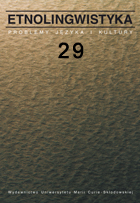Fuga daemonum, czyli dziurawiec jako amalgamat pojęciowy. Studium kognitywne
Fuga daemonum – St John’s Wort as a conceptual blend. A cognitive study
Author(s): Agnieszka Mierzwińska-HajnosSubject(s): Language and Literature Studies
Published by: Wydawnictwo Naukowe Uniwersytetu Marii Curie-Sklodowskiej
Keywords: cognitive semantics; conceptual integration theory; construction of meaning; conceptual blend; dynamicity
Summary/Abstract: The article aims to explore the cognitive mechanisms activated in conceptualising complex expressions, with the example of Fuga daemonum, a synonym to St John’s wort, a flowering plant from the family Hypericaceae, used as a herbal remedy to treat various physical and emotional ailments (in particular depression and anxiety). The four-space model of conceptual integration as proposed by Gilles Fauconnier and Mark Turner (2002) is used here for the purpose of the analysis. Fuga daemonum is found to be a conceptual blend, arising through a dynamism of a complex cognitive operation known as conceptual integration, where the activation of at least two distinct input spaces is required to arrive at the resultant meaning of the blend. In the case of Fuga daemonum, input space 1 refers to the appearance and properties of the plant, and input space 2 contains its symbolic and religious connotations. Thus, the process yields the emergent meaning of Fuga daemonum, which is not the sum of the meanings inherent in the input spaces but which becomes a new dynamic context-dependent expression.
Journal: Etnolingwistyka. Problemy Języka I Kultury
- Issue Year: 29/2017
- Issue No: 29
- Page Range: 31-45
- Page Count: 15
- Language: Polish

